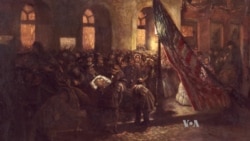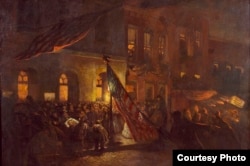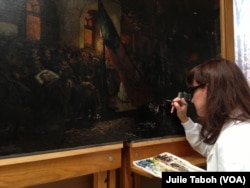There were no cameras outside Ford's Theatre on the night of April 14th, 1865, as a group of men carried a wounded man out of the building. But German artist Carl Bersch captured the scene on his sketchpad as he sat on a nearby porch.
A woman's face has a look of sheer horror. Around her a large crowd has gathered, their faces lit by the glow of a single street light. The wounded man is their president, Abraham Lincoln. Moments before, he and his wife Mary had been sitting in the balcony at the theatre watching a play when a gunman entered the presidential box and fired a single bullet into the back of Lincoln's head.
As his assassin, John Wilkes Booth, fled, the injured president was carried to the Petersen boarding house across the street, where he died the following morning. His death came just as he was leading the nation out of a long and bloody Civil War that had led to the death of more than 620,000 soldiers.
Bersch developed his sketch into an oil painting, “Lincoln Borne by Loving Hands.”
It is the only known painting by an eyewitness that captures the horror of that fateful night.
It is owned by the U.S. National Park Service, which has a vast collection of rare artwork and other artifacts of historic and cultural importance.
Laura Anderson, museum curator with the National Park Service, says Bersch was initially sketching a parade that was taking place on the street that night, celebrating the end of the Civil War. But his attention was soon drawn to the dramatic event that was unfolding before his eyes.
"He knew immediately it was a momentous scene that he was witnessing as he saw the president carried out onto the street."
Restoring a historic treasure
Since its creation more than 150 years ago, the painting has undergone several restorations, not all of them effective.
So the Park Service asked conservator David Olin to undo the previous damage and help restore the work to its original condition.
“In 30-something years of doing conservation, I have never seen a rendering of the event that took place outside of Ford's Theatre, recalling and capturing the aftermath of Lincoln’s assassination," said Olin. "So to me it's a very unique painting.”
Olin says he was fascinated "by the way that Carl Bersch captured not only Lincoln being carried out, but Lincoln is a very small facet of the overall design."
"I think the artist has really captured what was going on... the impact it had on the nation, with the activity in the background and the very dark, strong shadows," he explained.
He and his team spent about six months restoring the painting.
The first phase was to clean the painting, removing the previous layers without damaging the original content.
The second phase was doing structural repair, and the third phase involved “dot-by-dot inpainting pre-existing areas of abrasion and loss, with colors, pigments, that are age-tested and fully reversible.”
“So the objective, once the painting is cleaned and stabilized, is to bring back the artist's intent,” Olin said.
Tamara Luzeckyj, one of the team members who worked on the painting, seemed pleased with the final result.
“We’ve removed everything that's been obscuring that [painting] over the past hundred-something years and people can see it for what it originally was and be moved by that original painting, not the mask that we've been looking at for a long time.”
The artwork now hangs in the Ford’s Theatre museum, near the site where President Lincoln was assassinated.
Laura Anderson hopes that when visitors see the painting, they will think about what happened that night at Ford's Theatre, more than a century and a half before.
"It was a momentous occasion. It was the first time a president was assassinated; there was a peaceful transfer of power, and it was a very sad event and it was clearly felt by the artist who painted this painting.”
Many still regard Abraham Lincoln as one of the country's greatest and most beloved presidents. Bersch's painting is a poignant reminder of one of the darkest moments in American history.








